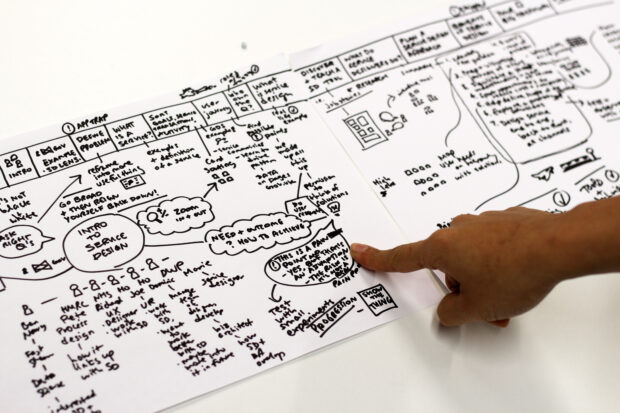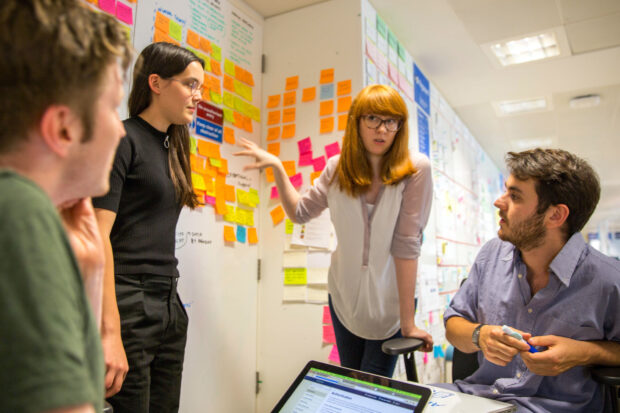
Designing public services is one of the most meaningful, satisfying and challenging things I’ve ever done. I get to think about the real intention behind what government is doing and help guide the people who work on services towards radically improved outcomes for citizens.
Often, people ask me how I got into this job. I’m happy to share my own story, but a lot of the time people are really asking ‘Is it possible for me to become a service designer? And, if so, how do I do it?’. So, in the style of GOV.UK, I thought I’d create a step-by-step guide.
1. Get interested in lots of things
One of the most striking hallmarks of all the great service designers I know is that they are relentlessly interested in the world, the people who live in it and how it all works. Harry Vos has a thing for shipping logistics. Kay Dale is big on DIY. Lou Downe is into just about everything from sailing to guerilla gardening.
Being interested in things is the first step to getting excited about making things better. Once you’re excited, well that’s when good ideas start happening. Service design is about having big ideas that are often very different to what’s come before, but there are no new ideas — everything is stolen from somewhere else. I’ve noticed that when I get excited, I’m usually taking something from somewhere else and putting it into a new context. To do that, you need to have a broad palette of interests to draw from. So read books, watch films, talk to interesting people. Follow threads that you’re already interested in and keep finding out more about how the world works.
2. Learn some design theory
I’m using the word ‘some’ here advisedly because (presumably) you’re not trying to become an academic, but understanding the basic principles of good design is essential in any design profession. My degree was in music, which taught me loads of important skills that I still use. Skills like working with other people, crafting and iterating an idea, and the relationship between audience and creator. But in terms of design theory, I’ve gotten by with having read a few books such as:
- The Design of Everyday Things by Donald Norman
- Universal Methods of Design by Bella Martin and Bruce Hanington
- Hooked: How to build habit-forming products by Nir Eyal
This is not an exhaustive list by any means, just a few that particularly helped me. I also learned a lot from reading the GOV.UK Service Manual and the Design in government blog. If you already work in the public sector, you might like to attend one of the training courses we run at GDS.
3. Learn what a service is and how to design one
There are some decent service design courses around these days (like the one at the Royal College of Art), but that certainly wasn’t my route.
Partly, I transitioned from music into tech thanks to the wide availability of free/cheap meetups and events. One great way to learn about service design is by going to events like these. Global Service Jams, Service Design Fringe Festival, and GovJam – supported by the Department for Work and Pensions – are all great examples of this.
But really, the fundamental thing to understand is there are no set outputs for a service designer – just a better service. Things like journey maps, blueprints, or workshops are all just tools you can use to get there.
The Design Council made a good thing highlighting some of these tools, but it’s quite prescriptive about the whole ‘double diamond’ thing, so do also read Kate Ivey-Williams on the dangers of that. This reading list from the GDS Service Design training is also great.
At some point, you’ll probably start asking ‘What actually is a service? And what makes a good one?’. We’ve been asking these things a lot at GDS in the last couple of years, so we came up with a working definition of what a service is and a list of characteristics of good services.
4. Deliver something
Service design is a strange job because it’s not management but you often can’t point at anything like a logo or a piece of code and say ‘I did that bit’. Sometimes I think it’s one of the biggest downsides of service design — it often feels like I haven’t done anything tangible. But service design is a team sport, so the impact of what I do – things like convincing people to take a wider perspective or be more ambitious while staying pragmatic – often has a massive impact on what actually gets made.
What taught me how to do this was running a startup. It made me understand the real pressures of trying to make something work for people while quickly running out of time and money. I was also lucky enough to have my startup supported by Bethnal Green Ventures, who brought in mentors including service designers to help us learn on the job. I also read The Lean Startup by Eric Ries around that time, which taught me what a ‘minimum viable product’ really is. The really crucial thing, though, is to just get some people around you and make something that really solves a problem for people. Watch how they use it, and iterate away!

5. Make friends with other service designers
Now, I’m not suggesting that civil servants should just hire their mates – that’s a terrible idea that unfairly excludes great people. We know that the more diverse our teams are, the better and more diverse the perspectives – and therefore design outcomes – are. However, it’s also true that getting to know other service designers outside of just sitting across an interview table from them will make you a better candidate. Even if you just meet for coffee once, having the chance to ask questions and understand the principles and ideas that are important to them is invaluable.
If you’re on Twitter or LinkedIn, message someone whose work you admire. If you go to a meetup or a conference, seek out a good speaker and talk to them. People are busy, but they can often make time for a coffee, and they’ll always feel complimented that you asked.
6. Apply for a job
Really, just go for it. At GDS we ask for portfolios, so we can get a sense of what you’ve actually helped deliver and what part you played in it. Once we’ve looked through that, we’ll invite the designers with the best work in for an interview. That sounds a lot scarier than it is but they’re more like conversations because both sides get to ask questions. So I’d say as soon as you have some good work to talk about, it’s worth applying.
Try and have a chat with someone senior who works for wherever you’re applying to about what level you should be shooting for before you apply, because if you’re transferring from another profession that will be taken into account. You can also look at the GOV.UK role descriptions to help you. It will really depend on what skills you have to work out what level is right for you.
7. Never stop learning!
How I describe my job to people now is different from how I described it 2 years ago. I hope it will be different again in another 2 years. The world is always changing, and service design is a profession that deals with that in the extreme.
We’re particularly lucky in government because we have a thriving cross-government design community which is continuously sharing best practice and pushing forward what ‘good’ looks like. It’s a good time to be designing public services!

4 comments
Comment by Debbie Murphy posted on
This is a brilliant article and so helpful - thank you!
Comment by James posted on
Is there an openly-available version of the GDS reading list? The Google Docs link is closed-access.
Comment by Martin Jordan - Head of Service Design, GDS posted on
Hi James! The reading list should be accessible for everyone again.
Comment by Mark posted on
What a great read and very complelling.